If five or six years have elapsed since your life raft was purchased or repacked, you are risking the chance that the raft wont deploy properly in an emergency. It’s also likely that some of the survival items stowed inside may now be useless.
Some life rafts are certified at packing for three years, others for five, but many sailors simply ignore the expiration date, waiting a couple extra years before going through the expensive inspection and repacking process. After all, routine repacking of life rafts aboard recreational sailboats isn’t required by law, so it’s up to the boat owner to shoulder the burden of responsibility.
Christopher Quill, service manager at Landrigan Corp., a life raft sales and repacking business in Boston, Mass., points out that apart from the safety factor, regular inspections can actually save money. Same with your car. If the engine or brakes haven’t been looked after, it can cost you a lot more money the next time you go to the garage. And people don’t depend on their car to save their lives out in the middle of the ocean.
Dan O’Connor, commercial sales and training coordinator at Life Raft and Survival Equipment (LRSE) in Tiverton, R.I., said that 90 percent of the life rafts brought to his service center for repacking are expired, usually by a few months, but some are five or more years out of date.
Flares are only good for three years. The food, water, and canopy light batteries are good for five years, as is hydrostatic [pressure] testing of the gas cylinder. That means that at five years, just about everything inside the raft must be replaced, O’Connor said.
Quill, who runs Landrigan’s service management office with his brother, Patrick, advises customers to stick with the maintenance schedule prescribed by the manufacturer. He also suggests getting the life raft repacked in the off-season, rather than rushing recertification to comply with the safety requirements of a sanctioned offshore race such as the Newport-to-Bermuda Race.
Although recreational boats that don’t take part in offshore racing are not required to maintain an up-to-date life raft inspection certificate-or even to carry a life raft on board-several organizations have introduced safety standards and survival equipment supply lists based on where and how the life raft might be deployed.
The International Sailing Federation (ISAF) supports safety standards prescribed by the International Maritime Organization (IMO) and the non-governmental International Organization for Standardization (ISO). Life raft safety standards are also recommended by International Convention for Safety of Life at Sea (SOLAS), and some of these have been adopted by US Sailing, the governing body for competitive sailing in the U.S. (SOLAS standards are much more stringent than those governing recreational life rafts.) Leisure-class life rafts do not require U.S. Coast Guard approval or certification, but it is a good idea to have your life raft checked by a facility that is licensed to service USCG/SOLAS life rafts for inspected vessels.
According to Quill, many sailors complain about the cost of repacking a life raft once the service date has elapsed. You’ve got seams, valves, and equipment in there that are constantly under pressure, and maybe the life raft is stowed in a hard case on deck or buried below in a valise, but in either instance, whatever is inside is feeling the wear, he explained.
Many raft owners are unaware that a fiberglass hardshell case-seemingly impervious to weather-has drain holes in the bottom. These holes eventually allow moisture to enter the case and wreak havoc. Take a wave over the side, and there is a good chance that your raft canister will absorb a bit of water. One way to add an extra-layer of protection is to have the raft vacuum-bagged before it is packed into a soft valise or hardshell case. This practice, still relatively new, has been shown to help prevent deterioration caused by moisture. Unfortunately, no method is bulletproof.
As O’Connor explained, in a tropical climate, heat and moisture can get inside, even if the raft is vacuum-bagged. Under the tropical sun, the package on deck is heating up to 150 to 160 degrees Fahrenheit, which affects things like the glue that holds the life raft together, he said.
It doesn’t take a marine expert to realize how quickly a saltwater environment can take its toll on flares, batteries, and pretty much anything electrical like the strobe light atop the raft canopy or the interior dome light. Under baking sun or exposed to brittle cold, the lift rafts rubbery fabric can also dry out and crack, especially along the folds.
Moisture also can affect the inflation firing-mechanism, or what O’Connor describes as the heart of the life raft. He added that with vacuum-bagging, theres less moisture, but it also means you have stretched the fabric, squashing everything into this tiny package and then vacuuming it to negative pressure. The longer you leave it in that state, the more you increase the chance of porosity or fabric leak.
The survival story told by solo sailor Steve Callahan in his book Adrift: 76 Days Lost at Sea, illustrates how important the condition of a raft can be in a survival situation. Although the use of Emergency Position Indicating Radio Beacons (EPIRBs) has greatly cut down the time a mariner is likely to spend awaiting rescue in his life raft, Callahans experience still serves as a good example of the kind of stresses the sea can impart on a lifeboat and the enclosed survival gear. In Callahans case, one of the rafts two floors deflated, exposing him to cold and shark attacks. His solar-powered, water-making stills didn’t work properly, and the packed galvanized fishing hooks had rusted and crumbled in his hands.
While it would seem like a good idea to custom-pack a life raft with the goodies you’d think necessary, this isn’t an option at most certified repacking centers. Neither Landrigan Corp. or LRSE honors customer requests to include additional items during life raft repacking, with the exception of prescription eyeglasses, vital medications, and photocopies of passports or credit cards.
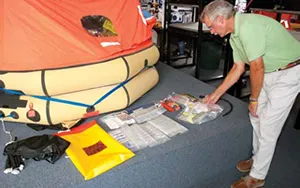
We have had people ask us to pack all sorts of things into the raft, but space is very tight, Patrick Quill explained. Better to pack the hand pump, the paddles, the rainwater catcher, the leak stoppers, fresh water, and flares. Quill did say that the inclusion of personal locator beacons (PLBs) is becoming more common now that technology has dramatically reduced the size and weight of such devices. For now, however, things like EPIRBs, portable VHFs, and Search and Rescue Transponders (SARTs) are relegated to the ditch bag. (Our June 2007 article on life raft survival gear included a long discussion on this topic.)
Customers frequently ask whether its a good idea to repack the life raft themselves. Steve Harvey, owner of Air-Sea Safety & Survival Inc., a survival equipment service center in Charleston, S.C., emphasizes that life raft repacking is a highly skilled service. Its not a job where you walk in off the street and start repacking life rafts, he said. Most manufacturers require a one-year apprenticeship.
Inspecting A Life Raft
To find out what a life raft repacking entails, Practical Sailor observed the repacking of a five-year-old, eight-person Viking recreational-grade life raft at the Landrigan service center in Boston. The inspection was conducted by technicians Chris and Patrick Quill. (PS was also given a tour of the Winslow life raft service facility in Florida to observe and photograph its inspection process.)
The inspection team at Landrigan quickly noted that the important safety information stickers on the Viking rafts yellowed hardshell case were severely faded, so the owners would not be able to read any of the important emergency instructions on the outside of the case.
The painter line, which secures the raft and its triggering system to the manufacturers metal cradle bolted to the boats deck, also appeared weathered. This braided umbilical cord was later replaced with a new cord that complied with the manufacturers standards.
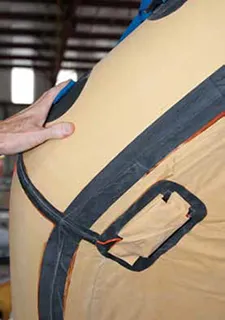
The Quill brothers snipped open the two plastic bands that held the gasket-rimmed hardshell case tightly closed. With the lid opened, they examined the vacuum-bagged raft. Using blunt scissors, they cut away the bag, which looked like a shiny space blanket, to expose the international orange-colored folded raft and the single, pressurized carbon-dioxide inflation cylinder, which was secured into place with two thin lines. They also inspected the valve on the vacuum bag itself, which is essential for sucking air out of the bag during repacking. Although that valve will be replaced along with a new vacuum bag, inspecting these valves and recording the wear pattern helps give manufacturers a better picture of their durability in the field.
Inspecting the brass break-stem valve atop the gas cylinder was next on the list, and of extreme importance. The valve stem is designed to break off as it is twisted when the inflation painter is tugged. When the valve breaks, it allows the pressurized gas to fill the rafts bottom floor chamber. The break-stem valve is a newer type of triggering mechanism. On older systems, a yank on the painter causes a spring-loaded spike or knife blade to puncture a hockey-puck-like disk atop the cylinder; this releases the gas into the rafts air chambers.
A third firing system made by SEI and Mirada Research relies on a slightly more complex plunger-style operation. It also uses a knife blade, but in this case, pistons and cables are used to initiate the inflation. Once the head is fired, a cable pulls out, and this lets the gas escape. This type of firing mechanism was highly rated by the inspection companies we spoke with for this article.
Removed from the raft, the steel gas cylinder is weighed to determine whether its heft matches the number inscribed on the cylinder. If the result is low on the scale, some of the gas has obviously escaped, so the cylinder must be refilled. A workbench test determines whether the cylinder needs additional attention. O-rings are replaced as a matter of routine.
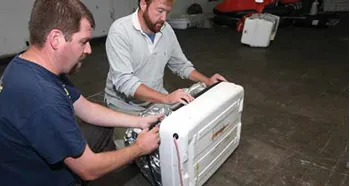
The cylinder, if it was sold in the U.S., should also bear a U.S. Department of Transportation (DOT) inspection date, indicating that it must be hydrostatically tested every five years. In the case of our sample eight-person raft, five years had elapsed, so the tank would need to be pressure-tested before it could be refilled.
Some manufacturers recommend emptying, testing, and recharging the gas cylinder during each three-year repacking interval. The reason: If the repacking company issues a new three-year certificate of compliance immediately following the third-year inspection, everything inside the life raft is technically still good for another three years. However, since the DOT-mandated hydrostatic test is required every five years, the gas cylinder would be one year beyond its recommended five-year inspection interval.
Harvey noted that the European Nation (EN) standard for hydrostatic tank testing is every 10 years, not five. Taking the longevity of tanks, particularly new tanks, into consideration, he said, At the three-year inspection, I would generally defer a customer from hydro-testing and let it run through the next cycle. That would give the customer some added value.
The Quills are accustomed to complaints about the seemingly high cost of maintaining something that hasn’t even been put into service. Theres a line we hear repeated by customers, Patrick Quill said with an amused grin. They say, I never even had to use it. And I say, Great. But Im thinking, does anybody really want to?
Continuing on with the inspection of the eight-man raft, the Quills spread it across the floor and carefully unfolded it. A thorough visual inspection of the exterior followed. The condition of the seams and fabric got a close look as did the line encircling the raft floor chamber. This important line serves as a handhold for people in the water. The line is vital for sailors to hang onto before climbing aboard or for regaining the life raft, if they get tossed out.
The exterior inspection also included the battery-operated canopy-top strobe light and the four lead-weighted ballast pockets on the bottom of the raft, designed to fill with water and keep the raft upright.
Inflation Test
After the initial visual inspection, the raft was inflated with compressed air to check for leaks or damaged seams. The inflation process is more complicated than one would think. Multi-tiered compressors push the air into the raft. During the process, moisture is removed by a series of dryers. The goal is to inflate the raft with bone-dry air. Any moisture introduced to the inside of the raft during the inspection process could stay in the raft as it is repacked, and this could accelerate deterioration. The U.S. Coast Guard conducts spot checks of life raft service centers and measures the moisture content. If the moisture content is too high, the repacking operation can be shut down.
In an emergency, the raft is inflated by pressurized carbon dioxide mixed with a trace of nitrogen. Nitrogen is considered a relatively dry gas and is added to ensure proper flow of the carbon dioxide, which tends to freeze when the cylinder is triggered. If all works properly, it should take about a minute to fill the raft at sea. A hand-pump stowed aboard the raft would be used to top off as needed, fill the uppermost of the two floor chambers, and to keep the canopy-arch tubes rigid.
Once the raft was standing, the Quills replaced the canopy-top strobe lights lithium batteries. They also made sure the rain-catching flap was functioning. The flap, shaped like a widely splayed V along one of the rafts exterior walls, channels rain to a plastic valve operated from inside the raft. The simple valve, fitted with about 10 inches of clear surgical tubing, controls the flow while filling empty, quart-size plastic bags with rainwater.
The technicians examined the window and door zippers, the Velcro closures, and the clear plastic window that allows occupants to peer out without exposing them to the weather. Soapy water was used to check for leaks at the pressurized seams. Lithium batteries in the interior dome light were replaced before testing the magnetic contact used to switch on the appliance.
The inflatable foot step just outside the door was pressure-tested and its seams were inspected, as was the webbing ladder tied across the raft floor; this provides handholds for those attempting to scramble aboard belly-first. Pressure-relief valves, which keep the raft from being damaged by overfilling once the gas cylinder is triggered, were also tested during the compressed-air inflation process.
Emergency Kit Inspection
Next on the inspection checklist was the tightly wrapped, clear plastic bundle on the raft floor. It contained handheld flares, parachute flares, an air pump, eight half-liters of water (one bag per person), a patch kit with glue, flashlight with extra batteries, printed survival instructions, conical leak-stoppers, a first-aid kit, barf bags, paddles, a sponge, a bailer, a sea-drogue anchor and lines, and rescue quoit (mini throw ring) and line.
The flares-good for three years-were expired and would be replaced. The sealed water pouches had a five-year lifespan and would be replaced as well. Although food items were not included in our test raft, they are required on some categories of rafts. These, too, must be replaced every five years.
The Quills inspected the buoyant safety knife tied near the door, used to cut the painter once everyone is aboard the raft-assuming the boat is sinking. The general rule is to stay tethered to the yacht for as long as possible without harming the raft or crew. If the boat is sinking too quickly to cut the tether, the line is designed to break before the boat can pull the inflated life raft under.
Many life rafts today are fitted with a Hammar hydrostatic release in the tie-down strap that secures the life raft to the boat deck or life-raft cradle. If the boat sinks prior to the rafts inflation, change in atmospheric pressure at a depth of approximately 12 feet will activate a sharp knife that releases the tie-down strap, allowing the life raft to float free. The Hammar release has its own inspection cycle: every two years.
Once the raft has been resupplied with emergency items, refolded and reconnected to the gas supply, the entire package is vacuum-packed-unless the model does not call for vacuum bagging.
The hardshell case is closed, and the lid gaskets are inspected for proper contact. A pair of heavy-duty compression straps, like those used by truckers to secure cargo, are wrapped around the case and cranked tightly until two plastic bands can be fitted into place to hold the case closed on the boat. As a final touch, new safety and operation labels are affixed to the exterior.
Adding It All Up
At Landrigan, its costs about $600 to repack the typical four-person to eight-person recreational life raft three years after purchase. At the six-year inspection, the cost increases to $1,000 because more supplies must be replaced. The repacking costs return to $600 at the nine-year mark.
By the time six years comes around, the gas cylinder is past due and most of the supplies have expired, said Patrick Quill. So maintenance averages out to $200 a year for the first three years and a bit more after that, but then the cost goes down again.
At LRSE, the estimated cost of repacking a non-vacuum bagged, four-person to eight-person leisure-class life raft is $500, plus another $300 to $350 for the vacuum-packed model.
While most leisure-class life rafts today are vacuum-packed, Harvey said that Switlik owners are given the option of foregoing this process because the materials used in its raft are not as vulnerable as others to moisture. Repacking costs at Switlik average about $280 for the inspection, $85 for the certificate, $40 for the hydrostatic cylinder test, and $55 for the refill-for a total of about $460. Miscellaneous supplies and shipping can easily add another $200.
To get a sense of the overall expense of life raft ownership, consider this: The new four-person Viking RescYou life raft is priced at $2,900 in a hardshell case and $2,750 in the valise. Spread over a projected 10-year lifespan, owning the raft in the hardshell case would cost $290 annually, plus another $200 to $335 per year for maintenance.
Shipping to and from a certified repacking company is another consideration because compressed gas and lithium batteries are regarded as hazardous materials, which will push up the cost and the governmental red tape. LRSE picks up and delivers from Maine to New Jersey for a fee of $150 each way. It also has an agreement with the West Marine retail chain in which life rafts can be dropped off and picked up at one of the stores for a round-trip fee of $90. Shipping a recreational raft, presuming it can be properly packed by the owner and the potentially hazardous materials inside clearly documented, costs about $150-$200.
Other boatyards participate in the program, but it’s usually easier to tell the life raft owner where the nearest West Marine is located, said O’Connor, noting that West Marine does not mark up the shipping cost. They benefit because it gets a customer through their doors-twice.
Air-Sea Safety & Survival picks up and delivers life rafts at the dock for a fee of $85 each way.
At the average repacking station, turnaround time for repacking a leisure raft can vary greatly. If you are planning to have a raft packed in the spring, just as the North American sailing season kicks off, or late fall when many cruising sailors are heading to the Caribbean, you should allow at least three to four weeks.
For more information about life raft selection and emergency gear, be sure to read our three-part series on this topic that ran in the March, April, and May 2007 issues. The March issue offers a primer on life raft features, while the April issue features tests of six-man life rafts. In the May issue, testers compared the rafts quality and quantity of such items as emergency flares (handheld and parachute), signaling mirrors, bailers, drogues, paddles, and flashlights.
Many sailors have little clue to what their lifesaving pod might contain. Candy? A chess set? Whisky sour mix and a few nips of Jim Beam?
Life raft survival kits used by the recreational yachting community can generally be divided into five categories based, in part, on the distance in miles the yacht will be sailing from shore. Types of emergency survival packs include ISO Pack I, ISO Pack II, SOLAS B Pack, Offshore Pack (Type E), and Coastal Pack.
Other kits such as the SOLAS A Pack, which would also carry food provisions, are not part of the lineup since they were assembled for commercial vessels operating 50 or more miles from shore.
Some basic equipment is contained in all five recreational yachting packages, so these items are excluded from the accompanying PS contents chart.
These basic items include paddles, sea anchor with line, bailer, sponge, bellows or pump, instructions for survival, table of life-saving signals, water bags, leak stoppers, rescue quoit and line, and buoyant safety knife.
Additional equipment such as sunscreen, fishing gear, food rations, radar reflectors, and smoke signals depend on the type of recreational life raft survival package as shown in the chart.
For a more detailed analysis of life raft safety gear, see the May 2007 issue of Practical Sailor.
Life Raft Emergency Supplies
The compressed gas and inflation system is regarded as the heart of the inflatable life raft. Mechanisms that trigger inflation can vary by manufacturer. The gas used to inflate the raft is usually the same—a dry mixture of carbon dioxide and a trace of nitrogen. During inspection, another source of gas is used to inflate the raft. Makers warn against testing your own raft by inflating it as this can introduce water vapor to the inflation chambers that can cause problems over the long-term if not removed before repacking. In recent years, two life raft makers Viking (Thanner 65-type valve; recall announced in 2007) and Switlik (S-2630 inflation valve; recall announced in 2008) have issued voluntarily recalls due to concerns about the inflation valves.
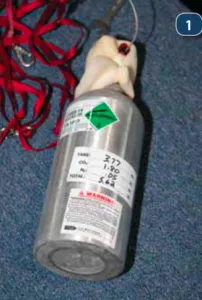
1. A gas canister used to inflate a Winslow coastal raft clearly indicates the gas mixture used in the tank.

2. A technician at Winslow inspects the Miranda Research inflation valve for a Winslow life raft. Made primarily of lightweight anodized 6061 aluminum, the two-piece cutter type valve is versatile and considered to be very reliable, but like virtually all inflation systems, it is not immune to corrosion—thus the need for routine inspection.
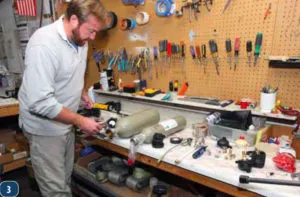
3. A technician at Landrigan Corp. inspects canisters prior to servicing. O-ring gaskets on the inflation systems are always replaced.






























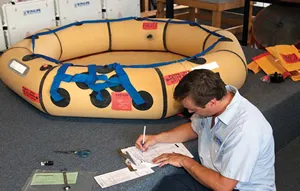








Hello! Good morning!
Im Captain LUCAS SASONE im a helicopter pilot of Argentinean Air Force and im in charge of the ALSE equipment of my Air unit (7th air base, Helicopters and special forces unit), we have here 3 life rafts WISLOW 710 FA-AV (UL) and 4 WISLOW 1421 FA-AVA (U) out of service because those life rafts need the 5 years inspection.
I need a budget to do those inspections in USA or another country near Argentina that can do the inspection through a representative of winslow.
our official email is escuadron1ga7@faa.mil.ar
thank you for your help!
best regards
One observation you might have overlooked?
After 12 or 13 years, the cost of certification is nearly as high as the cost of a new raft.
It seems that this might be the life of the raft.
Any comment or experience about the Portland Pudgy as a viable alternative to a packed life raft?
I have owned a 6-person Viking life raft for seven years. I had it serviced at an approved facility in Florida three years ago and the total price for the service was around $1300. The raft did not require anything other than the normal service. This service price was well above what I was told to expect when I purchased the raft for around $2100 at a boat show. I’m thinking I may just buy a another life raft from another manufacturer rather than go through this experience again.
There is an alternative. When you buy a boat already with a raft or if you buy a raft used, the cost to repack is very daunting. So far better than ignoring it is do it yourself. I did and was overall very glad that I did.
1. I can repack it with what I want.
2. I know for sure what is going on with the raft.
3. Parts were a bit of a pain but overall easier than I thought it would be.
4. Saved a lot of money and again, much better that ignoring it
As has been pointed out by many, it’s almost to the point of if I have to spend that much, just buy an new one.
So I thought that even if I can’t finish it, I’m no worse off. And much better than ignoring it. Is it as good as having the pro’s do it? No, but a good alternative that I now trust.
Glad that I did it.
Makes sence to me. Thanks for the comment
“The survival story told by solo sailor Steve Callahan in his book Adrift: 76 Days Lost at Sea, illustrates how important the condition of a raft can be in a survival situation. In Callahans case, one of the rafts two floors deflated, exposing him to cold and shark attacks. His solar-powered, water-making stills didn’t work properly, and the packed galvanized fishing hooks had rusted and crumbled in his hands.”
You’re leaving out some important info given that the article is about liferaft inspections, i.e., was Callahan’s liferaft inspection current, and if so, what went wrong? Also, how old was the raft, and when was its last inspection? Without this or more info, his story tells us nothing useful.
Steve’s story is one of many similar anecdotes of substandard equipment being packed aboard, and problems with inflation systems. We address these topics in great detail in our ebook series, Survival at Sea: Liferafts. https://www.practical-sailor.com/product/life-rafts. The anecdote was included to remind owners to, as much as possible, take a serious hands-on approach to liferaft inspection and equipping. Regardless of who or when the liferaft was inspected, it is clear from Steve’s own account that the process would have benefitted from greater oversight. As I recall Steve commented at one point in his gripping tale, that the raft’s warranty (or certification?) had expired. In a sense, the liferaft served it’s purpose — albeit with a superhuman effort on the part of the survivor.
The community need life-rafts that offers self service and inspection using a step by step guide.
The cost inspection at most places in the US is ridiculously high and far from being justified by the work or parts needed. A typical case where the need creates inflated cost (should I mention some boatyards practices?).
A self inspected and repacked life raft will build higher trust by sailors, as they’ll be able to test the raft inflation and proper operation more frequently, rather than trusting a ‘black box’
Perhaps members of your community could pay someone with liferaft repacking experience to conduct a workshop.
I, too, would like to see that happen; at least one would know the extent of such a project, and as said above, it would be better than having out date l/raft of unknown condition.
Years ago I had a switlik raft in a Fiberglas case serviced by an authorized service center. It cost a fortune and the case came back chipped and chunked out from some kind of abuse. Or I got somebody else’s raft, who knows! This hardly inspires confidence. I’ve heard of people finding their raft was junk and unusable a short time after service. I’d prefer dealing with a manufacturer who services what they make. Why not? Who does that?
It’s fun to see the YouTube community inflating rafts that are 40 years old – 35 years past inspection – and they work! I get that the food and batteries won’t be any good, but the essential purpose of safety flotation in an emergency is still served.
Everything in life has some risk, and sailors leave port every day assessing that risk for every system boat-wide. Since the certification centres do not trigger the existing mechanisms to test the raft, we do not have any data of potential failure rates. Therefore, we don’t have the necessary information to assess the risk of an out-of-date raft performing well or poorly. That doesn’t give me confidence that any life raft is a guarantee of safety at sea.
We got a Givens ‘lifebuoy8′ just before a Feb ’93
delivery of a Jeanneau 37’ cat to Bahamas…and learned 1 year later didn’t have it’s epirb/food.
Jim (Givens) seemed like a good guy…but was
selling incomplete raft kits. Inspections can be a
lifesaver. Even with a totally new unit. Inspite of a night of 74 kt breezes, we made it. Feb 19-Mar1.
P.S. it’s always good to bring an epirb/extra water/ food in the bailout bag.
I agree with all comments on inspection costs being ridiculously high. The old story of Steve Callahan’s experience (pre GPS 1980’s) belongs in the horse and buggy days. With a modern EPIRB and the worldwide routing of ships via GPS and multinational Cospas Sarsat network the likelihood of being in a raft for more than week is extremely unlikely.
I am new to this scene. After reading the comments about the cost. It seems that one would deploy your life raft before having it serviced. It looks like that’s what the repacking is. It would at least let you know if it would have worked.
I am a DIY person I am sure inspection and repacking is not that hard. BUT without the recertification sticker you would be taking on all the responsibility if there were a failure with loss of life. That being said I trust my own work.
Maybe we should just rent them